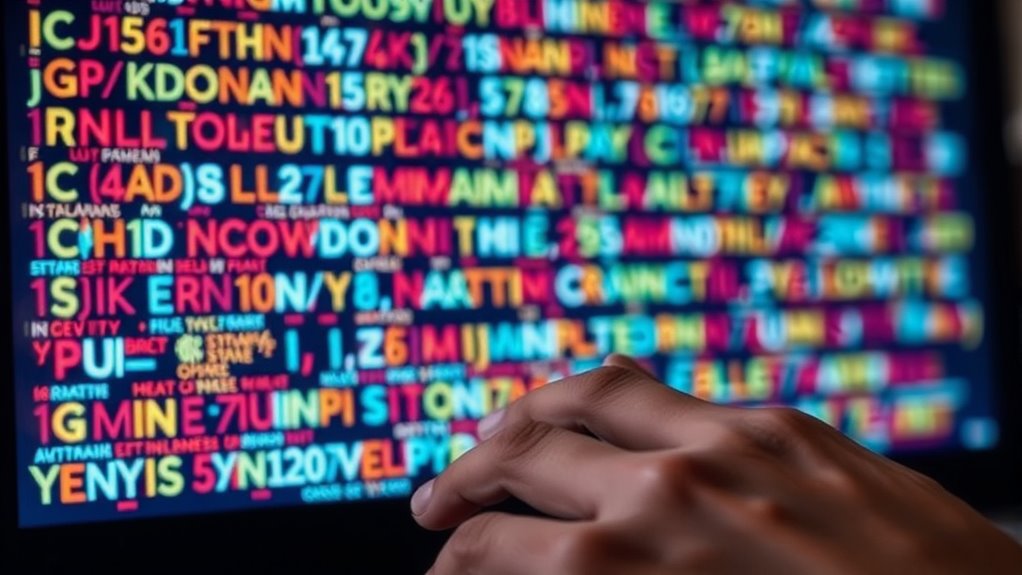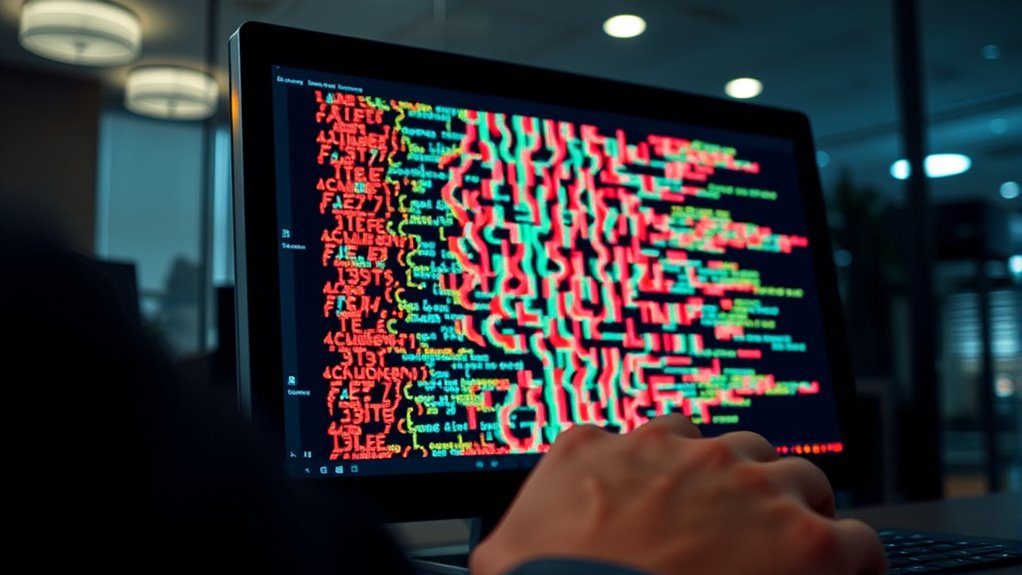CAPTCHA systems work by presenting challenges that are easy for humans but hard for bots, like recognizing images or typing distorted text. They verify you’re human by analyzing your responses and interaction patterns. These challenges help protect websites from spam, fake accounts, and security threats. While they’re effective, attackers are always finding new ways to bypass them. Understanding how CAPTCHA evolves keeps you one step ahead—if you keep exploring, you’ll learn more about its future and challenges.
Key Takeaways
- CAPTCHA presents tasks that are easy for humans but difficult for bots, such as recognizing images or distorted text.
- It verifies user identity by analyzing interaction patterns like mouse movements and response times.
- CAPTCHA helps prevent spam, fake accounts, and malicious activities by blocking automated scripts.
- Various types include visual puzzles, audio challenges, and advanced ReCAPTCHA systems for enhanced security.
- Ongoing developments aim to balance effective security with accessibility and user-friendly experiences.
The Purpose Behind CAPTCHA Systems

To understand the purpose behind CAPTCHA systems, it’s important to recognize that they protect websites from automated abuse. These systems serve as a form of user verification, ensuring that a real person is interacting with the site. By filtering out bots, CAPTCHA helps prevent spam, fake accounts, and malicious activity, keeping online environments safer and more trustworthy. While their primary goal is security, they also impact user experience. A well-designed CAPTCHA balances challenge with ease of use, so genuine users can quickly verify themselves without frustration. This process maintains smooth access while blocking automated threats. Ultimately, CAPTCHA systems help websites stay secure while trying to provide a seamless experience for legitimate visitors. Additionally, understanding how CAPTCHA interacts with user verification techniques can further improve online security measures.
Types of CAPTCHA Challenges

There are various types of CAPTCHA challenges designed to distinguish humans from bots effectively. These challenges often test your ability to interpret visual puzzles or respond to audio challenges. Visual puzzles may ask you to select images with common features or solve a distorted text. Audio challenges play sounds or words you need to identify, helping those with visual impairments. Here’s a quick overview:
| Type | Description | Example |
|---|---|---|
| Visual Puzzle | Recognize images or solve distorted text | Picking all traffic lights |
| Audio Challenge | Listen and identify spoken words or sounds | Transcribing spoken words |
| ReCAPTCHA | Combine visual and audio elements for verification | Select all squares with cars |
In addition, some CAPTCHA systems incorporate filtration techniques to improve accuracy and prevent automated responses.
How CAPTCHA Verifies Human Users

CAPTCHA verifies human users by presenting challenges that are easy for people to solve but difficult for automated bots. This process guarantees effective user verification and identity confirmation, preventing unauthorized access. When you complete a CAPTCHA, you’re proving you’re human through tasks like identifying objects, typing distorted characters, or selecting specific images. These tasks leverage your ability to interpret visual or auditory cues, which bots struggle with. To enhance security, CAPTCHA systems may analyze your interaction patterns, such as mouse movements or response times. This adds depth to user verification. Additionally, some CAPTCHA systems incorporate Eye Patch Benefits to analyze visual recognition, further distinguishing humans from bots. In essence, CAPTCHA’s goal is to differentiate humans from bots reliably and efficiently, maintaining the integrity of online services and protecting sensitive data from automated threats.
The Technology Powering CAPTCHA

You’ll see that CAPTCHA relies on advanced algorithms and techniques to tell humans apart from bots. These systems analyze user responses to identify patterns unique to humans or automated scripts. Understanding how these detection methods work helps you appreciate the technology behind CAPTCHA’s effectiveness. Additionally, some CAPTCHA systems adapt their challenges based on the behavioral analysis of users to improve accuracy and security.
CAPTCHA Algorithms and Techniques
At the core of CAPTCHA technology are sophisticated algorithms and techniques designed to distinguish humans from automated bots. These methods leverage machine learning and pattern recognition to analyze user responses and behavior. Machine learning models are trained on vast datasets to identify subtle differences between human input and automated scripts. Pattern recognition helps detect irregularities in how users interact with challenges, such as timing or mouse movements. These algorithms adapt over time, improving accuracy and resilience against evolving bot tactics. To add depth, CAPTCHA systems incorporate various techniques like image analysis, text distortion, and behavioral analysis. This layered approach makes it increasingly difficult for bots to bypass security measures, ensuring that genuine users gain access without inconvenience. Additionally, ongoing research into user authentication enhances these systems’ ability to reliably differentiate real users from malicious automation.
Human vs. Bot Detection
The core of human versus bot detection lies in analyzing how users interact with challenges and identifying patterns that distinguish genuine behavior from automated scripts. Behavior analysis tracks your clicking speed, mouse movements, and interaction timing to spot inconsistencies typical of bots. Biometric verification adds another layer by examining unique user traits, such as typing rhythm or touch gestures, to confirm authenticity. These techniques work together to differentiate real users from automated scripts, making it harder for bots to bypass security measures. By continuously monitoring interaction patterns, CAPTCHA systems adapt and improve, ensuring that only humans gain access. Incorporating multi-factor authentication further enhances security by requiring additional verification methods, thereby reducing the risk of automated breaches. This combination of behavior analysis and biometric verification provides a reliable method for detecting bots while maintaining a smooth experience for genuine users.
Common Challenges and Limitations

You might find that clever attackers develop techniques to bypass CAPTCHAs, making them less effective over time. At the same time, accessibility barriers can prevent some users from completing challenges easily. As automated attacks become more sophisticated, keeping CAPTCHA systems secure remains an ongoing challenge.
CAPTCHA Bypassing Techniques
While many attackers attempt to bypass CAPTCHAs using automated tools, they often face significant challenges due to evolving security measures. Modern CAPTCHAs leverage machine learning to detect suspicious activity, making simple automation ineffective. Attackers also struggle with maintaining data privacy, as advanced systems analyze subtle user interactions rather than just visual patterns. Techniques like OCR or image recognition are thwarted by complex puzzles and adaptive algorithms. To overcome these barriers, attackers might try:
- Using AI-driven tools to analyze and solve CAPTCHAs in real-time
- Exploiting vulnerabilities in poorly implemented CAPTCHA systems
- Employing data privacy loopholes to gather sensitive information indirectly
- Cybersecurity vulnerabilities becoming more complex as security measures adapt, emphasizing the ongoing arms race between attackers and defenders.
Accessibility Barriers Persist
Have you ever encountered difficulty completing a CAPTCHA? Many people rely on assistive technology or require inclusive design to navigate online content. Traditional CAPTCHAs often create accessibility barriers, especially for users with visual impairments or motor disabilities. For example, distorted text or image-based challenges can be nearly impossible for screen readers or alternative input devices to interpret accurately. Despite efforts to improve accessibility, these barriers persist, preventing equal access for all users. Developers need to prioritize inclusive design, ensuring CAPTCHAs accommodate diverse needs without compromising security. Until more accessible solutions become standard, a segment of users will continue facing challenges, highlighting the ongoing need for balance between security measures and universal accessibility. Additionally, fostering awareness about digital inclusivity can drive innovation toward more equitable online experiences.
Evolving Automated Attacks
As automated attackers continue to evolve, they pose increasing challenges to CAPTCHA effectiveness by developing more sophisticated methods to bypass security measures. They now leverage machine learning to analyze patterns and generate responses that mimic human behavior. These attackers can study user behavior, such as mouse movements and click timing, to fool CAPTCHAs that rely on behavioral cues. Additionally, they use AI algorithms to solve visual puzzles or decode audio challenges with increasing accuracy. This ongoing evolution makes it harder for CAPTCHAs to stay ahead of automated threats. To counter this, you need to understand these limitations and adapt security measures accordingly. Moreover, the advancements in AI security emphasize the importance of continuously improving CAPTCHA systems to address emerging vulnerabilities.
The Future of CAPTCHA and Online Security

The future of CAPTCHA and online security is poised to evolve rapidly as technology advances. AI advancements will lead to smarter, more adaptive systems that can better distinguish humans from bots, making CAPTCHAs more effective. However, these innovations also raise privacy concerns, as new methods might require collecting more user data to verify identities. You may see the development of invisible or seamless CAPTCHAs that operate in the background, reducing user friction while maintaining security. As technology advances, balancing robust security with user privacy will become vital. You’ll need to stay informed about these changes to understand how your data is being used and to ensure your online experiences remain safe without compromising your privacy.
Frequently Asked Questions
Can CAPTCHA Differentiate Between Humans and Advanced AI Bots?
You might wonder if CAPTCHA can tell humans and advanced AI bots apart. It uses behavior analysis, examining how you interact, like mouse movements and typing patterns, to identify humans. Some CAPTCHAs also incorporate biometric verification, such as recognizing unique traits. While advanced bots get better at mimicking humans, these techniques help CAPTCHA distinguish real users from bots, maintaining online security and preventing automated abuse.
Are There Alternative Methods to CAPTCHA for Online Security?
You can explore alternatives like biometric authentication and behavioral analysis for online security. Biometric methods, such as fingerprint or facial recognition, verify your identity more seamlessly. Behavioral analysis tracks your online habits to detect unusual activity, adding an extra layer of protection. These methods often provide a smoother user experience while maintaining security, reducing reliance on traditional CAPTCHA challenges, and helping to prevent automated attacks more effectively.
How Do Visually Impaired Users Navigate CAPTCHA Challenges?
When you encounter CAPTCHA challenges, visually impaired users rely on assistive technology like screen readers and audio options to navigate. Accessible design guarantees these users can verify they’re human without visual cues, providing alternatives such as audio CAPTCHAs or descriptive prompts. These features help you and others with disabilities complete verification smoothly, making online security more inclusive and user-friendly for everyone.
What Are the Privacy Implications of CAPTCHA Data Collection?
Imagine you’re filling out a form online, unaware that your responses are being collected. CAPTCHA data collection raises privacy concerns because it gathers information like your IP address and interaction patterns, which can be misused or compromised. This affects your data security, making you vulnerable to tracking or breaches. You should be aware that while CAPTCHA helps prevent bots, it also poses risks to your personal privacy that demand careful regulation.
How Effective Is CAPTCHA Against Evolving Cyber Threats?
You wonder how effective CAPTCHA is against evolving cyber threats. It leverages machine learning to improve bot detection, making it more difficult for automated attacks to succeed. While no system is perfect, CAPTCHA adapts by analyzing user behavior and distinguishing humans from bots. As cyber threats grow smarter, CAPTCHA’s evolving algorithms help you stay protected, but you should also combine it with other security measures for better defense.
Conclusion
Understanding how CAPTCHA works is like opening a secret gate to online safety. It’s your first line of defense against bots and malicious attacks, ensuring you’re truly human. While challenges exist, CAPTCHA evolves like a vigilant guardian, adapting to new threats. By appreciating its role, you become an active participant in safeguarding your digital space. Remember, just as a sturdy lock protects your home, CAPTCHA shields your online world—keeping it secure and trustworthy.









